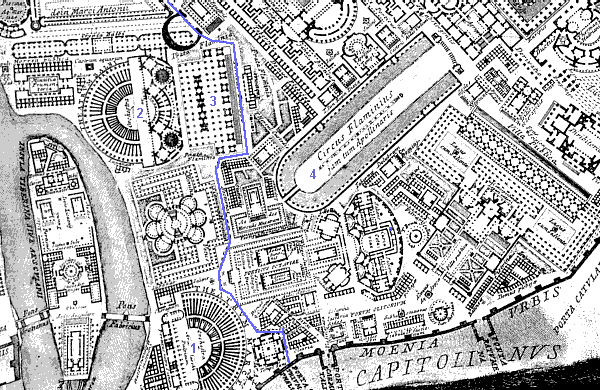
Upon following the Triumphal Way in its reverse direction, one immediately encounters the Theatrum Marcelli (1), which forms a pair with the Theatrum Balbi (2) further up along the way. As with the Porticus Philippi (3), Piranesi transposed the true site of the Theater of Balbus with the true site of the Circus Flaminius (4). This transposition of structures is surely among the first archaeological mistakes within the Ichnographia easily recognized by anyone familiar with ancient Rome's topography, and hence has fostered the overall criticism of Piranesi's plan as fragmentary fantasy. What the critics have failed to see, however, is that Piranesi's "mistakes" most often signify innuendo. In this case, the two theaters are literal indications that the Triumphal Way, and indeed the entire Ichnographia, represent a double theater, more precisely a double theater where one stage set is the inversion of the other. Likewise, as much as the city of Philippi relates to Augustus and the very beginnings of the Empire, it also fits squarely within Christianity since it was the Philippians who established the first Christian Church of the West.
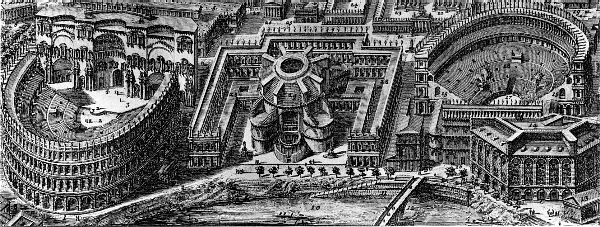
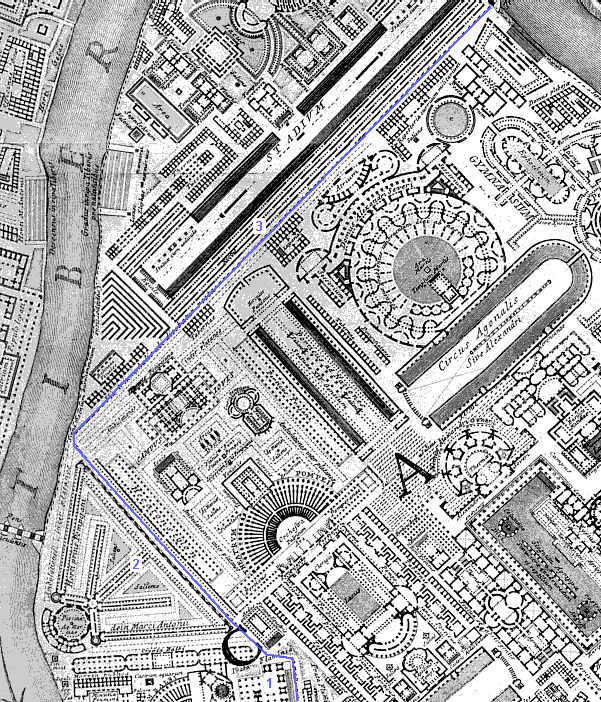
As the reverse Triumphal Way proceeds beyond the Porticus Philippi (1) there are no direct references to the Rome's Pagan - Christian inversion, however the theme of inversion itself is present. The long wall of the Horti prius Pompejani dein Marci Antonii (2), the Gardens formerly of Pompey and later of Marc Antony, which runs parallel to the Triumphal Way comprises a series of colonnaded niches which alternate between being on the inside wall and being on the outside wall. In a similar fashion, the structure supporting the stands of the large Stadium (3) along the Triumphal Way comprises alternating series of columns and walls in both the long and short direction. In both cases, Piranesi employs simple plan formations that subtly enhance the Triumphal Way with emblems of inversion.
| |
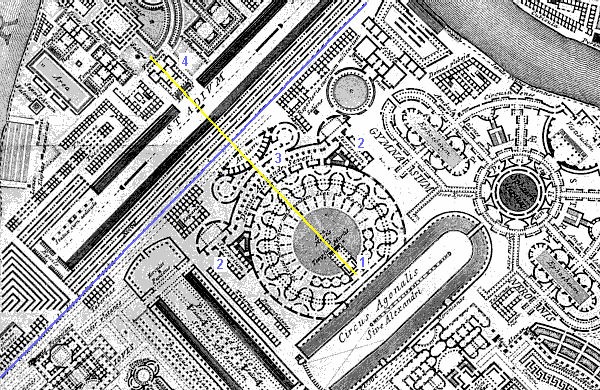
As the reverse Triumphal Way reaches the halfway point of the Stadium, it again crosses a significant axis, whose meaning too inverts from pagan to Christian. The axis, which spans from the Templum Martis (1) to the Templum Romuli (4), in its original sense symbolizes the very beginnings of Rome. When comparing this portion of the Ichnographia with Nolli's map of Rome, however, it becomes clear that Piranesi's position of the Templum Martis coincides exactly with the present day church of S. Agnese in Agone, the legendary site of the brothel to which St. Agnes was sent as a form of torture prior to her subsequent martyrdom. Agnes was supposed to lose her virginity in the brothel, a virginity she vowed to Christ. Agnes was not raped in the brothel, however, because of the protection of an angel; therefore Agnes was killed as a virgin. The execution of virgins was against Roman law and ethics, thus, the martyrdom of Agnes became a symbol of paganism's own corruption. In aligning the Templum Martis with S. Agnese in Agone, Piranesi makes an inverted link between Mars raping the Vestal Virgin Rhea, which brought forth Romulus and Remus and the founding of Rome itself, and the non-rape and virgin martyrdom of Agnes, which is one of the leading contributors towards the rise of Christianity in Rome.
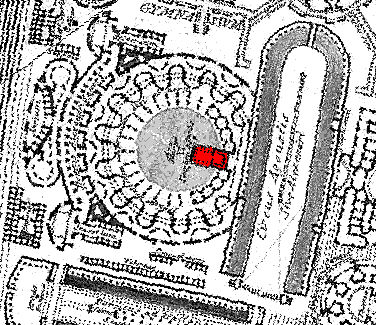 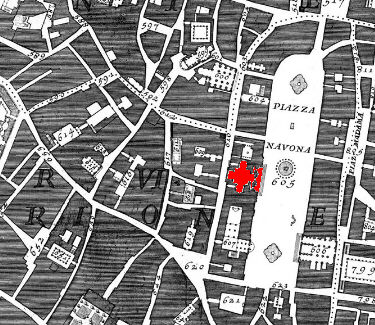
Piranesi reinforces the double meaning of the Templum Martis complex by including the Domus Alexandri Severi (3 above) and two Sessorium (2 above). Neither the Domus Alexandri Severi nor the Sessorium existed within this section of Rome, and Piranesi's placement of these buildings within the Campo Marzio is another example where the archaeological mistakes of the Ichnographia signify an "other" meaning. The emperor Alexander Severus is known for having been very interested and sympathetic towards Christianity, to the point where he seriously considered proclaiming Jesus as one of the official Roman gods, and he also carved the (inverting) words "do unto others as you would have them do unto you" over the door of his house. The Sessorium, on the other hand, is a direct reference to the Palatium Sessorianum, the imperial estate that became St. Helena's residence in Rome after 312, and subsequently the church of Santa Croce in Gerusalemme. St. Helena is the mother of Constantine the Great.
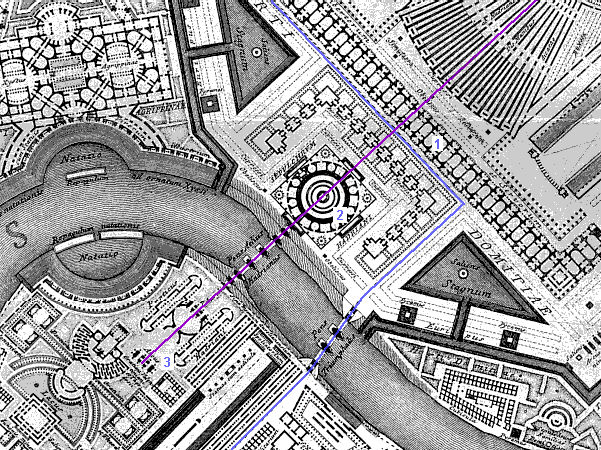
Beyond the Stadium, the reverse Triumphal Way crosses the Tiber and turns around the Sepulchrum Hadriani (Hadrian's tomb) (2). It is here that the Triumphal Way as delineated by Piranesi begins to reflect true archaeology, albeit inverted. After the reign of Constantine the Great, the triumphal processions within Rome no longer terminated at the Temple of Jupiter on the Arx, but rather culminated at St. Peter's Basilica in the Vatican valley. This explains why there was indeed a Via Triumphalis along the east bank of the Tiber across from the Campus Martius. It is historical fact that once the emperors of the Roman Empire converted to Christianity, the Triumphal Way in Rome also changed its course, and Piranesi continually expresses this religious conversion via symbolic inversion. As the reverse Triumphal Way of the Ichnographia turns to proceed behind the Sepulchrum Hadriani, it moves beside a long row of Sepulchra Libertorum et Servorum (1), tombs of free men and slaves. The repetitive plan of these tombs itself delineates inversion with each tomb being a flipped plan of the tombs next to it, and, moreover, free men and slaves are obvious inversions of each other. Furthermore, the Sepulchrum Hadriani, establishes an axis of death. At the southern terminus of this death axis Piranesi positions the Arcus Gratiani Valentiniani et Theodosii (3), the Arch of Gratian, Valentinian and Theodosius, which actually did exist in this part of Rome. It was the Emperor Theodosius who instituted Christianity as the state religion of the Roman Empire, while, at the same time, he outlawed all paganism.
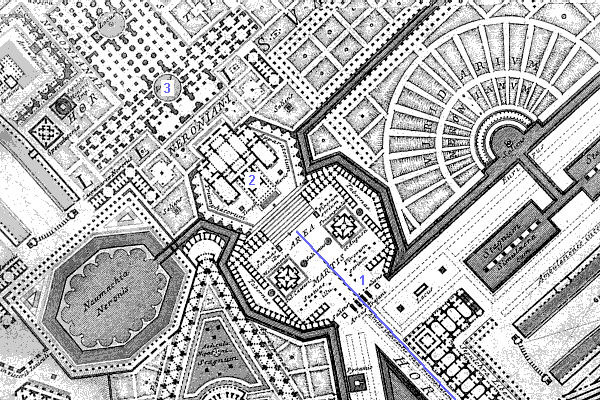
Ultimately, the reverse Triumphal Way passes through the Arcus Trajani (Arch of Trajan) and arrives at its end in the place where Piranesi's pagan Triumphal Way began. As already demonstrated, Piranesi's rendition of the Templum Martis (Temple of Mars) and the Area Martis inversely matches exactly the scale and composition of St. Peter's Basilica and Piazza. The polygonal Area Martis inverts into the Piazza of St. Peter's, the Templum Martis inverts into the grand stairs leading to St. Peter's Basilica, and the Porticus Neroniani inverts into St. Peter's Basilica itself. Neither the Area Martis, the Templum Martis (2), the Porticus Neroniani (3), nor the Arcus Trajani (1) actually existed in this part of Rome, and again Piranesi's archaeological mistakes signify the presence of double entendres. The connections between the Area and Templum Martii and the Piazza of St. Peter's are obvious -- each is a gathering place for their respective "triumphs". The Porticus Neroniani possesses manifold duplicity -- Peter was executed in the Circus of Caligula and Nero during the reign of Nero, and subsequently buried next to the Circus within Nero's garden, and the cruciform plan of the Porticus Neroniani, as much as it is an inverted (upside down) plan of St. Peter's Basilica, also signifies the means of Peter's execution, an upside down crucifixion. Finally, the tiny key that confirms and locks the inverted paths of the Ichnographia's Triumphal Way is Piranesi's placement of the Arcus Trajani, which marks the beginning of the pagan path and at the end of the Christian path. In 315 AD, the Arch of Trajan was dismantled, moved, redesigned, and rebuilt as the Arch of Constantine.
| |

|